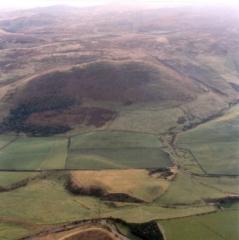| |

|
| |

|
The Great Enclosure remained in use, being rebuilt at least four or five times, from this
time through to Anglo-Saxon times and the reign of King Edwin in the 7th century AD.
Find out more about:
|
|
|
Yeavering Archive: Site Origins
The Anglo-Saxon palace at Yeavering, known as Ad Gefrin, owes it origins to an adjacent hill known as Yeavering
Bell, which dominates the landscape. The top of the bell is the location of the largest hillfort in Northumberland,
which sits amongst a dense concentration of similar and broadly contemporary sites.
On top of the Bell, a massive drystone wall encloses 13 acres of closely packed circular house foundations. This site
was no small village. Instead, perched on this mountain, an entire town existed 2000 years ago. The town was
abandoned sometime around the 1st century; it is not clear why, but the apparent deliberate flattening of the
drystone walls suggests that the site may have been destroyed as part of Roman suppression.
The power base subsequently shifted from the Bell to the site that became known as Ad Gefrin. The site of Ad Gefrin
had already been occupied for thousands of years before it became the site of the Anglo-Saxon settlement. From about
2000BC it had attracted cremation burials, ritual pits, a burial mound and a stone circle, clearly suggesting that
this land was considered to be sacred.
Later, around the 1st century BC/AD the land was used for agriculture and when
these fields fell out of use, around the 4th or 5th centuries AD or earlier, the Great Enclosure was built. At this
time the burial mound was still visible and the builders chose to include it within their palisade. The stone circle
was dismantled and replaced by wooden structures, which marked the location of a cemetery.
|
|
|
 |